Unveiling the allure of gold within stone, this guide from rockscapes.net will help you identify gold in rock formations, understand its various forms, and recognize the geological contexts where it’s found. Discover how to distinguish genuine gold from look-alikes and explore the mesmerizing world of gold-bearing rocks. Get ready to transform your understanding of gold prospecting and landscape design with precious metal elements.
1. What Exactly Does Gold Look Like in a Rock Formation?
Gold in a rock manifests in various ways, typically as metallic yellow flakes, grains, or nuggets embedded within the host rock. The appearance of gold varies depending on its purity, the size of the particles, and the minerals it’s associated with.
Expanding on this, gold rarely exists in its pure form within rocks. Instead, it’s often alloyed with other metals like silver, copper, and platinum. These alloys can subtly alter the color of the gold, making it appear more silvery or reddish. The size of the gold particles also plays a significant role in its appearance. Large, easily visible nuggets are rare, while fine, microscopic gold is far more common. Furthermore, the surrounding minerals can influence how gold appears. For instance, gold encased in quartz might appear as bright, metallic veins, while gold associated with iron oxides might have a more subdued, rusty appearance. Understanding these nuances is crucial for successful gold prospecting and appreciating the diverse beauty of gold-bearing rocks.
 Gold ore
Gold ore
2. What are the Common Types of Gold Ores?
Gold ores are generally classified based on their mineral associations and geological origins, including quartzose ores, auriferous copper ores, auriferous lead ores, gold-telluride ores, and disseminated ores. These categories help prospectors and geologists understand where and how gold is likely to be found.
2.1 Quartzose Ores
Quartzose ores are characterized by a gangue mineral that is acidic, such as quartz. According to research from Arizona State University’s School of Earth and Space Exploration, in July 2025, quartz is one of the most abundant minerals on Earth, making quartzose veins a common target for gold prospecting. Fluorite and other alkaline earth minerals may also be present. These ores frequently contain pyrite, chalcopyrite, and galena. They are often referred to as “free milling ores” because they do not require roasting before amalgamation, a process where gold is extracted using mercury.
2.2 Auriferous Copper Ores
Auriferous copper ores contain significant amounts of copper, often in the form of chalcopyrite, which is gold-bearing. These ores are commonly found in Colorado, Utah, Montana, British Columbia, Gold Hill, North Carolina, and Newfoundland. The presence of copper alongside gold can make these ores economically valuable.
2.3 Auriferous Lead Ores
Auriferous lead ores have a high lead content but often contain only small amounts of gold. Like copper ores, they are considered “refractory ores,” meaning they require roasting before amalgamation to release the gold.
2.4 Gold-Telluride Ores
Gold-telluride ores contain gold combined with tellurium and other elements like silver, lead, and antimony. These ores are often sent directly to smelters for processing due to their complex mineral composition. An example of this type of ore is Calaverite, a gold, silver, and tellurium mineral. This type of mineral can be up to 40 percent gold by weight. Tellurides are often associated with rich ore deposits.
2.5 Disseminated Ores
Disseminated ores are low-grade but large-volume deposits. They occur in extensive fracture and fault zones or replace specific geological horizons. These ores are formed by the circulation of large amounts of heated water deep underground, which deposits gold over a wide area. The Carlin Trend in Nevada is a prime example of a disseminated gold deposit. These ores consist of silicified rock and often were originally some sort of limy shale. Over the last 50 years, this district has become the most productive gold district in the US, producing over 60 million ounces of gold to date.
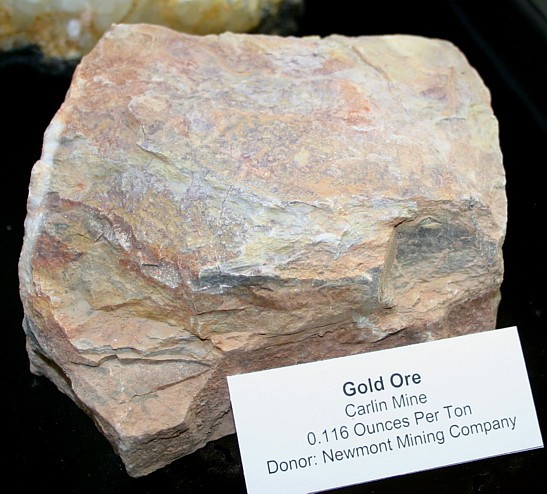 Carlin type gold ore
Carlin type gold ore
3. Where is Gold Typically Found in a Rock?
Gold is often found in fissures, seams, or layers within rocks, particularly near the hanging wall or footwall of fissure veins. It can also concentrate in pockets or “bonanzas,” where the gold content is exceptionally high.
Elaborating further, gold’s distribution within a rock is rarely uniform. Fissure veins, which are fractures in the rock filled with minerals, are a common site for gold deposition. These veins can vary greatly in value, with the richest gold often occurring in concentrated pockets. In some mining belts, systematic exploration along the main fissure vein can lead to the discovery of these bonanzas. The gold may be present as a thin seam or film, sometimes almost invisible to the naked eye, or the entire vein material may be rich enough to justify extraction. Additionally, gold can be found in the propylitic type of deposit, where metasomatic alterations of the wall rock result in secondary minerals like chlorite and epidote. The type of rock the vein traverses—igneous or sedimentary—has little influence on gold presence, except in cases of replacement.
4. What Minerals are Commonly Associated with Gold in Rocks?
Common minerals associated with gold include pyrite (fool’s gold), quartz, tellurides like calaverite and sylvanite, chalcopyrite, galena, arsenopyrite, and stibnite. Recognizing these minerals can indicate the potential presence of gold.
Expanding on this, pyrite, often called “fool’s gold,” is an exceedingly common associate of gold. While pyrite itself doesn’t contain gold in a chemically bonded form, its presence can indicate geological conditions favorable for gold deposition. Quartz is another frequent companion, often hosting gold within its crystalline structure. Tellurides, such as calaverite and sylvanite, are minerals in which gold is chemically bonded with tellurium. These minerals are often associated with rich ore deposits. Other sulfides like chalcopyrite, galena, arsenopyrite, and stibnite can also host gold, although typically in smaller amounts than pyrite. Being familiar with these associated minerals can significantly aid in identifying promising gold-bearing rocks.
5. What Geological Formations are Most Likely to Contain Gold?
Geological formations most likely to contain gold include quartz veins, placer deposits, volcanic rocks, and areas with hydrothermal activity. Understanding these formations helps focus prospecting efforts.
Going deeper, quartz veins are among the most common geological formations associated with gold. These veins form when mineral-rich fluids circulate through fractures in the Earth’s crust, depositing gold and other minerals as they cool. Placer deposits, such as riverbeds and gravel terraces, are another significant source of gold. These deposits form when gold is eroded from its original source and transported by water, concentrating in areas where the water flow slows down. Volcanic rocks, particularly those associated with hydrothermal systems, can also host gold deposits. Hydrothermal activity, where heated water circulates through rocks, can dissolve and redeposit gold, creating rich ore bodies. Areas with a history of tectonic activity and faulting are also promising, as these processes can create pathways for mineral-rich fluids to circulate.
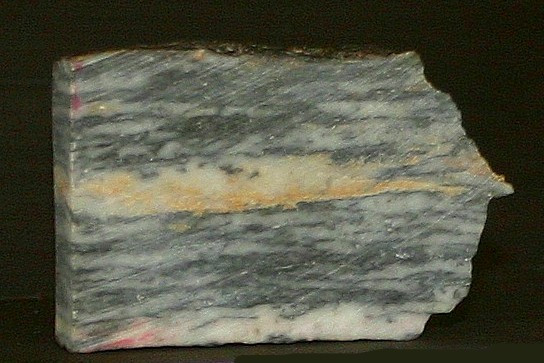 Russian gold ore
Russian gold ore
6. How Can You Distinguish Real Gold from Fool’s Gold (Pyrite) in a Rock?
Real gold is soft, malleable, and has a distinct yellow color that doesn’t tarnish. Pyrite, or fool’s gold, is brittle, harder, and has a brassy yellow color. The streak test can also help: gold leaves a yellow streak, while pyrite leaves a blackish-green streak.
Explaining further, the physical properties of gold and pyrite differ significantly. Gold is incredibly soft and malleable, meaning it can be easily shaped and hammered without breaking. Pyrite, on the other hand, is brittle and will shatter if struck. Gold’s color is a deep, rich yellow that remains consistent even when tarnished, while pyrite has a brassy, almost greenish-yellow hue. The streak test is another reliable method. Rubbing gold across a streak plate (a piece of unglazed porcelain) will leave a yellow streak, while pyrite will leave a blackish-green streak. Additionally, gold is much denser than pyrite; a small piece of gold will feel significantly heavier than a similar-sized piece of pyrite. These simple tests can help even novice prospectors distinguish real gold from its deceptive look-alike.
7. What Tools are Helpful for Identifying Gold in Rocks?
Essential tools for identifying gold in rocks include a magnifying glass or jeweler’s loupe, a streak plate, a geological hammer, a gold pan, and a metal detector. These tools aid in visual inspection, mineral testing, and sample collection.
Adding to this, a magnifying glass or jeweler’s loupe is invaluable for close-up examination of mineral samples. These tools allow you to identify small gold particles and associated minerals that might be missed with the naked eye. A streak plate is used to perform the streak test, which helps differentiate gold from pyrite and other minerals. A geological hammer is essential for breaking rocks and collecting samples. A gold pan is used to separate gold from sediment and gravel in placer deposits. Finally, a metal detector can be used to locate buried gold nuggets and ore samples. For more advanced analysis, geologists and prospectors may also use more sophisticated tools like X-ray fluorescence (XRF) analyzers, which can provide detailed information about the elemental composition of a sample.
8. What is the Significance of the Term “Gold Ore”?
“Gold ore” refers to a naturally occurring rock or sediment that contains enough gold to be economically extracted. The grade (concentration) of gold in the ore determines its value and whether it’s worth mining.
Gold ore can be further defined by its geological context, mineral composition, and the methods used to extract the gold. High-grade ore contains a higher concentration of gold and is typically more valuable than low-grade ore. The economic viability of mining gold ore depends on several factors, including the gold price, the cost of extraction, and the environmental regulations in place. As technology advances and gold prices fluctuate, what is considered economically viable ore can change over time.
9. How Does Weathering Affect the Appearance of Gold in Rocks?
Weathering can alter the appearance of gold in rocks by oxidizing surrounding minerals, exposing gold particles, or causing the gold to become more concentrated in certain areas. Oxidation can create a rusty or stained appearance around the gold.
Elaborating on this, weathering processes like oxidation, hydrolysis, and carbonation can break down the surrounding rock matrix, exposing gold particles that were previously hidden. Oxidation can also alter the color of associated minerals, such as pyrite, which can create a reddish-brown stain that contrasts with the yellow color of gold. In some cases, weathering can lead to the formation of secondary gold deposits, where gold is dissolved and reprecipitated in more concentrated forms. However, weathering can also have negative effects, such as dispersing gold particles and making them more difficult to recover. Understanding how weathering affects gold’s appearance and distribution is crucial for effective prospecting and mining.
This sample of vein quartz from Mariposa exemplifies the typical gold-quartz material found in California’s Mother Lode district.
10. Can Gold’s Appearance in a Rock Indicate its Purity or Origin?
Yes, to some extent. The color and luster of gold can provide clues about its purity and origin. For example, gold with a reddish tint may contain more copper, while gold with a paler color may have a higher silver content. The geological context of the rock can also provide insights into the gold’s origin.
Expanding on this, the color of gold is directly related to its composition. Pure gold has a rich, yellow color, while the presence of other metals can alter this hue. Silver, for example, tends to lighten the color of gold, while copper can impart a reddish tint. The luster, or how light reflects off the gold’s surface, can also provide clues. Bright, metallic luster is typically associated with relatively pure gold, while a duller luster may indicate the presence of surface coatings or impurities. Additionally, the geological setting in which the gold is found can offer valuable information about its origin. For instance, gold found in volcanic rocks may have a different origin and composition than gold found in sedimentary placer deposits.
11. What are the Ethical Considerations When Collecting Gold-Bearing Rocks?
Ethical considerations when collecting gold-bearing rocks include obtaining permission from landowners, respecting mining claims, minimizing environmental impact, and adhering to local regulations. Responsible collecting ensures the sustainability of natural resources and protects the interests of others.
Elaborating further, before collecting any rocks, it’s essential to obtain permission from the landowner. Many areas are privately owned, and collecting without permission is illegal. If the area is public land, it’s crucial to check for existing mining claims. Claim holders have the right to the minerals in that area, and trespassing on their claim is both unethical and illegal. When collecting, minimize your environmental impact by avoiding sensitive areas, filling in any holes you dig, and packing out all trash. Be aware of and adhere to local regulations regarding rock collecting, which may include restrictions on the type and amount of material you can collect.
12. How Can Rockscapes.net Help You Find and Identify Gold-Bearing Rocks?
At Rockscapes.net, we offer a wealth of resources to help you identify gold-bearing rocks and incorporate them into your landscape designs. Our website features detailed guides, stunning visuals, and expert advice on various types of rocks and minerals, empowering you to create captivating outdoor spaces that showcase nature’s artistry.
At Rockscapes.net, you can explore a vast collection of articles and images showcasing different types of gold ores, learn about the geological formations where gold is typically found, and discover the tools and techniques used for gold prospecting. Whether you’re a homeowner looking to add a touch of natural beauty to your garden, a landscape designer seeking unique materials for your projects, or a supplier looking for new trends and products, Rockscapes.net provides the information and inspiration you need. Contact us at 1151 S Forest Ave, Tempe, AZ 85281, United States, or call +1 (480) 965-9011 to learn more. Visit our website, rockscapes.net, and start your journey to discover the beauty and value of gold-bearing rocks today.
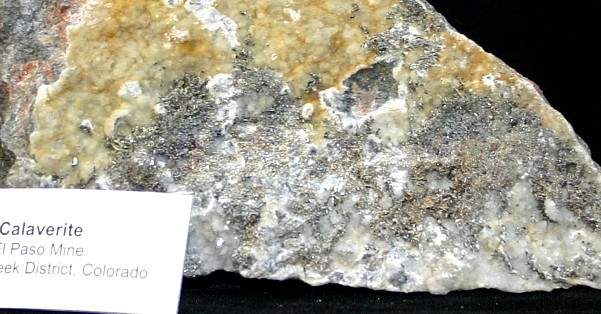 cripple Creek gold ore, Colorado
cripple Creek gold ore, Colorado
13. What Role Does Gold Play in Landscape Design?
Gold, whether in the form of gold-bearing rocks or metallic accents, can add a touch of luxury and natural beauty to landscape designs. Gold-flecked stones can be incorporated into pathways, water features, or decorative rock gardens, creating stunning visual effects.
Elaborating further, gold-bearing rocks can be used to create focal points in gardens or outdoor living spaces. The contrast between the earthy tones of the rock and the shimmering gold can be particularly striking. Gold can also be incorporated into water features, such as fountains or ponds, where the movement of the water enhances the gold’s reflective qualities. Additionally, gold can be used as a subtle accent in pathways or retaining walls, adding a touch of elegance and sophistication. When used thoughtfully, gold can elevate a landscape design from ordinary to extraordinary.
14. What Are Some Creative Ways to Use Gold-Bearing Rocks in Landscaping?
Creative uses for gold-bearing rocks in landscaping include building a gold-flecked rock garden, creating a shimmering water feature, incorporating gold into pathways or retaining walls, and using gold as a decorative accent in outdoor living spaces.
Some of the most captivating outdoor living spaces are designed with gold-flecked rocks that are utilized to craft striking water features where the movement of water enhances the reflective qualities of the gold. Gold accents in the pathways or retaining walls enhance the property’s elegance and sophistication. A well-placed gold element elevates your landscape design from ordinary to extraordinary.
15. What Safety Precautions Should You Take When Handling Gold-Bearing Rocks?
When handling gold-bearing rocks, it’s important to wear gloves to protect your hands from sharp edges and potential contaminants. Avoid inhaling dust from the rocks, and wash your hands thoroughly after handling them. Store rocks in a secure location to prevent accidents.
Going deeper, many rocks can have sharp edges or contain trace amounts of potentially harmful substances. Wearing gloves provides a barrier between your skin and the rock, preventing cuts and exposure to these substances. When breaking or crushing rocks, always wear safety glasses and a dust mask to protect your eyes and respiratory system. It’s also important to properly label and store your rock samples, especially if they contain potentially hazardous minerals.
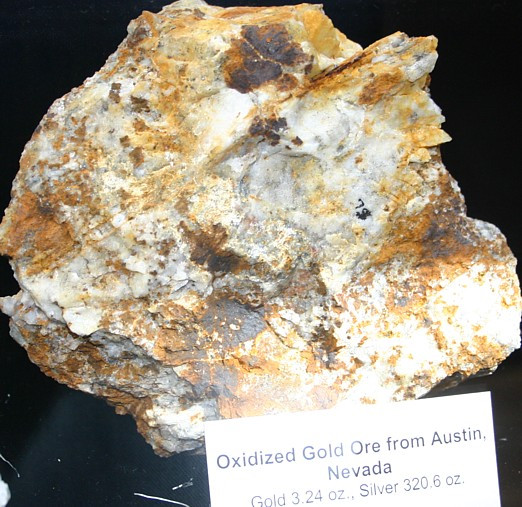 Austin, Nevada silver and gold ore
Austin, Nevada silver and gold ore
16. How Does the Price of Gold Affect Gold Prospecting and Mining Activities?
The price of gold has a direct impact on gold prospecting and mining activities. Higher gold prices make it economically viable to mine lower-grade ores and encourage increased exploration and production. Lower gold prices can lead to mine closures and reduced prospecting efforts.
When gold prices are high, mining companies are more willing to invest in exploration and development of new gold deposits. This can lead to increased prospecting activities and the opening of new mines. Higher prices also make it economically feasible to mine lower-grade ores that would not be profitable at lower prices. Conversely, when gold prices fall, mining companies may be forced to close down operations and reduce exploration budgets. This can lead to job losses and a decline in gold production.
17. What are Some Famous Gold Mining Locations in the USA?
Famous gold mining locations in the USA include California’s Mother Lode, Nevada’s Carlin Trend, Alaska’s Juneau Gold Belt, and Colorado’s Cripple Creek. These regions have a rich history of gold production and continue to be significant sources of gold today.
The Mother Lode in California was the epicenter of the California Gold Rush in the mid-1800s and has produced millions of ounces of gold. The Carlin Trend in Nevada is a world-class gold mining district known for its large, disseminated gold deposits. The Juneau Gold Belt in Alaska has a long history of underground gold mining and continues to be a productive region. Cripple Creek in Colorado was the site of a major gold rush in the late 1800s and is still home to active gold mines.
18. How Do Mining Regulations Impact Gold Prospecting and Extraction?
Mining regulations play a crucial role in governing gold prospecting and extraction activities. These regulations aim to protect the environment, ensure worker safety, and manage natural resources responsibly. Compliance with these regulations is essential for sustainable and ethical gold mining practices.
Mining regulations can cover a wide range of issues, including permitting requirements, environmental impact assessments, water management, waste disposal, and reclamation. These regulations can vary depending on the jurisdiction and the type of mining activity. Prospectors and mining companies must comply with all applicable regulations to avoid penalties and ensure that their operations are environmentally sound and socially responsible.
19. What Are Some Common Misconceptions About Finding Gold?
Common misconceptions about finding gold include the belief that gold is always easy to spot, that all shiny yellow minerals are gold, and that gold is always found in large nuggets. In reality, gold can be difficult to identify, often occurs in small particles, and requires knowledge and skill to locate.
Expanding on this, many people believe that gold is easily recognizable and can be found simply by looking for shiny yellow rocks. However, gold can occur in a variety of forms and may be associated with other minerals that obscure its appearance. Additionally, not all shiny yellow minerals are gold; pyrite, mica, and chalcopyrite can all be mistaken for gold by inexperienced prospectors. Another common misconception is that gold is always found in large, easily visible nuggets. While nuggets do exist, they are relatively rare. Most gold occurs in small flakes or particles that require careful panning or processing to recover.
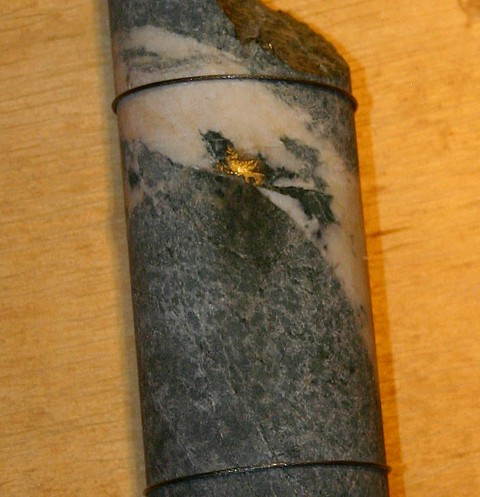 Alaska gold Quartz ore
Alaska gold Quartz ore
20. Where Can You Learn More About Gold Prospecting and Rock Identification?
There are many resources available to learn more about gold prospecting and rock identification, including books, websites, geological surveys, and prospecting clubs. Rockscapes.net offers a wealth of information and resources for both beginners and experienced prospectors.
The internet provides access to a vast amount of information on gold prospecting and rock identification. Websites like rockscapes.net offer detailed guides, images, and expert advice on various aspects of geology and mineralogy. Geological surveys, such as the U.S. Geological Survey, provide maps, reports, and data on mineral resources in different regions. Prospecting clubs and organizations offer opportunities to learn from experienced prospectors, participate in field trips, and share information. Additionally, there are many books and field guides available that cover the basics of rock and mineral identification, as well as advanced techniques for gold prospecting.
FAQ About How Gold Looks Like in a Rock
Q1: Is all that glitters gold?
No, not all that glitters is gold; pyrite, also known as “fool’s gold,” is a common mineral that can be mistaken for gold.
Q2: How can I tell if a rock has gold in it?
Look for a bright, metallic yellow mineral that is soft and malleable. Perform a streak test; gold leaves a yellow streak, while pyrite leaves a blackish-green streak.
Q3: What kind of rocks is gold found in?
Gold is commonly found in quartz veins, placer deposits, and volcanic rocks.
Q4: Can gold be found in any type of rock?
While gold is more common in certain types of rocks, it can be found in various geological formations.
Q5: How does the color of gold in a rock affect its value?
The color of gold can indicate its purity; the rich yellow color shows its pureness, but other elements, like silver, can alter it.
Q6: What are some tools needed to find gold in rocks?
A magnifying glass, streak plate, geological hammer, gold pan, and metal detector are essential tools for identifying gold in rocks.
Q7: Is gold found in all states in the USA?
Gold has been found in many states in the USA, but it is more prevalent in certain regions like California, Nevada, and Alaska.
Q8: How does weathering affect gold in rocks?
Weathering can expose gold particles and concentrate them in certain areas.
Q9: Are gold-bearing rocks valuable?
Gold-bearing rocks can be valuable depending on the amount of gold they contain.
Q10: Can I make money finding gold in rocks?
Finding gold in rocks can be a profitable hobby or business, but it requires knowledge, skill, and dedication.
Dive deeper into the world of rock formations with related content:
